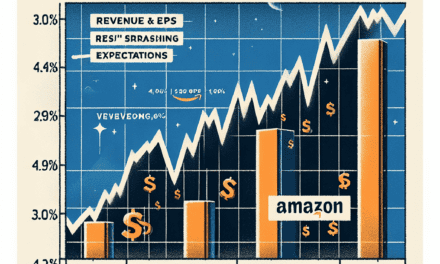“Crop Prices Soar as Harvest Projections Dwindle!”
Introduction
Crop prices have surged significantly in recent months, driven by lower harvest projections that have raised concerns among farmers, traders, and consumers alike. Adverse weather conditions, pest infestations, and supply chain disruptions have contributed to diminished yields for key agricultural commodities. As a result, market dynamics are shifting, leading to increased prices that reflect the growing scarcity of these essential goods. This surge not only impacts the agricultural sector but also has broader implications for food security and inflation, prompting stakeholders to closely monitor developments in crop production and market trends.
Crop Price Trends Amidst Lower Harvest Projections
In recent months, the agricultural sector has witnessed a significant surge in crop prices, a trend that can be largely attributed to lower harvest projections. As various factors converge to impact crop yields, market dynamics have shifted, leading to heightened prices for essential commodities. This phenomenon is not merely a reflection of supply and demand but is also influenced by a complex interplay of environmental, economic, and geopolitical factors.
To begin with, adverse weather conditions have played a pivotal role in shaping harvest expectations. Unseasonably dry conditions in key agricultural regions have resulted in diminished crop yields, prompting analysts to revise their forecasts downward. For instance, droughts in the Midwest have raised concerns about corn and soybean production, two staples that significantly influence global food supply chains. As these projections become more pessimistic, market participants react swiftly, driving prices upward in anticipation of tighter supplies.
Moreover, the impact of climate change cannot be overlooked. As weather patterns become increasingly erratic, farmers face greater uncertainty regarding planting and harvesting schedules. This unpredictability not only affects immediate crop yields but also has long-term implications for agricultural planning and investment. Consequently, as farmers grapple with these challenges, they may be less inclined to plant certain crops, further constraining future supply and contributing to rising prices.
In addition to environmental factors, economic considerations also play a crucial role in the current crop price landscape. The ongoing global economic recovery has led to increased demand for agricultural products, particularly in emerging markets. As countries rebound from the pandemic, their appetite for food and feed has surged, placing additional pressure on already strained supply chains. This heightened demand, coupled with lower harvest projections, creates a perfect storm for rising prices, as buyers compete for limited quantities of available crops.
Furthermore, geopolitical tensions have exacerbated the situation. Trade disputes and sanctions can disrupt the flow of agricultural goods across borders, leading to localized shortages and inflated prices. For instance, recent conflicts in key exporting nations have raised concerns about the stability of supply chains, prompting buyers to secure contracts at higher prices to mitigate risks. As a result, the interconnectedness of global markets means that fluctuations in one region can have far-reaching implications for crop prices worldwide.
As prices continue to rise, the implications for consumers and producers alike are significant. For consumers, higher crop prices often translate into increased costs for food products, which can disproportionately affect low-income households. On the other hand, producers may benefit from elevated prices, as they can potentially offset some of the losses incurred from lower yields. However, this situation is not without its challenges; farmers must navigate the complexities of market volatility and input costs, which can erode profit margins.
In conclusion, the surge in crop prices amid lower harvest projections is a multifaceted issue driven by environmental, economic, and geopolitical factors. As the agricultural landscape continues to evolve, stakeholders must remain vigilant and adaptable to the changing dynamics. Understanding these trends is essential for making informed decisions, whether one is a farmer, a consumer, or an investor in the agricultural sector. As we move forward, the ability to anticipate and respond to these challenges will be crucial in ensuring food security and stability in the marketplace.
Impact of Weather Conditions on Crop Yields
The impact of weather conditions on crop yields is a critical factor that influences agricultural productivity and, consequently, market prices. As farmers rely heavily on favorable weather patterns to cultivate their crops, any deviation from expected climatic conditions can lead to significant fluctuations in yield. For instance, excessive rainfall can lead to waterlogged fields, which may hinder root development and increase the risk of diseases. Conversely, drought conditions can severely limit water availability, stunting plant growth and reducing overall harvests. These weather-related challenges are not merely localized; they can have far-reaching implications on a national and even global scale.
In recent years, the unpredictability of weather patterns has become increasingly pronounced, largely attributed to climate change. This phenomenon has resulted in more frequent and severe weather events, such as hurricanes, floods, and prolonged droughts. As a result, farmers are finding it increasingly difficult to predict the optimal planting and harvesting times, which can lead to lower yields. For example, a late frost can damage young plants, while an early frost can cut short the growing season, both scenarios contributing to diminished crop outputs. Such unpredictability not only affects the immediate harvest but also has long-term implications for soil health and fertility, further complicating future planting cycles.
Moreover, the impact of weather conditions extends beyond just the immediate effects on crop yields. It also influences the decisions farmers make regarding crop selection and management practices. In regions where droughts have become more common, for instance, farmers may opt for drought-resistant varieties or alter their irrigation practices. While these adaptations can mitigate some of the adverse effects of changing weather patterns, they often require significant investment and may not always yield the desired results. Consequently, the uncertainty surrounding weather conditions can lead to a cautious approach among farmers, which may further exacerbate supply issues in the market.
As crop yields fluctuate due to adverse weather conditions, the ripple effects are felt throughout the agricultural supply chain. Lower harvest projections can lead to increased prices for consumers, as the supply of certain crops diminishes. This scenario is particularly evident in staple crops such as wheat, corn, and soybeans, where even minor reductions in yield can lead to significant price surges. Additionally, higher prices can strain food security, particularly in regions that rely heavily on imports for their staple foods. As a result, the interplay between weather conditions and crop yields not only affects farmers and consumers but also has broader implications for global food systems.
Furthermore, the volatility in crop prices due to lower harvest projections can create challenges for policymakers and agricultural stakeholders. Governments may need to intervene to stabilize markets, which can involve implementing subsidies or adjusting import tariffs. However, such measures can be contentious and may not always address the underlying issues related to climate variability. Therefore, it is essential for stakeholders to invest in research and development aimed at improving crop resilience to changing weather patterns. By fostering innovation in agricultural practices and technologies, the industry can better adapt to the challenges posed by unpredictable weather, ultimately leading to more stable crop yields and prices.
In conclusion, the impact of weather conditions on crop yields is a multifaceted issue that significantly influences agricultural markets. As climate change continues to alter weather patterns, understanding and addressing these challenges will be crucial for ensuring food security and stabilizing crop prices in the future.
Economic Factors Driving Crop Price Increases
In recent months, the agricultural sector has witnessed a significant surge in crop prices, a phenomenon primarily driven by lower harvest projections. This increase can be attributed to a confluence of economic factors that have created a perfect storm for both producers and consumers. As weather patterns become increasingly unpredictable, the impact of climate change on agricultural yields has become more pronounced. For instance, droughts, floods, and unseasonable temperatures have led to diminished crop outputs in key producing regions, thereby tightening supply chains and elevating prices.
Moreover, the rising costs of inputs such as fertilizers, seeds, and fuel have compounded the challenges faced by farmers. As global demand for these inputs escalates, driven by both inflationary pressures and supply chain disruptions, farmers are forced to pass on these costs to consumers. Consequently, the price of crops has risen, reflecting not only the immediate effects of lower harvest projections but also the broader economic landscape that influences agricultural production. This situation is further exacerbated by geopolitical tensions that disrupt trade routes and create uncertainty in international markets. For example, conflicts in major agricultural exporting countries can lead to export restrictions, further constraining supply and driving prices upward.
In addition to these external pressures, domestic policies and trade agreements play a crucial role in shaping crop prices. Subsidies and tariffs can either mitigate or exacerbate the effects of supply shortages. When governments implement protective measures to support local farmers, it can lead to higher prices for consumers, as the market adjusts to the new economic realities. Conversely, the removal of trade barriers can sometimes lead to an influx of cheaper imports, which may temporarily stabilize prices but can also undermine local agricultural sectors in the long run.
Furthermore, the increasing global population and changing dietary preferences are contributing to heightened demand for certain crops, particularly grains and protein sources. As more people move into urban areas and adopt diets that include more meat and dairy, the demand for feed crops has surged. This shift not only places additional pressure on crop prices but also highlights the interconnectedness of agricultural markets worldwide. As countries strive to secure their food supplies, competition for limited resources intensifies, leading to further price increases.
Another critical factor influencing crop prices is the role of speculators in agricultural markets. Financial investors often view commodities as a hedge against inflation, leading to increased trading activity in crop futures. This speculative behavior can amplify price volatility, as market participants react to news about weather conditions, harvest forecasts, and geopolitical developments. Consequently, the prices of crops can fluctuate dramatically in response to perceived risks, further complicating the economic landscape for both producers and consumers.
In conclusion, the surge in crop prices due to lower harvest projections is a multifaceted issue influenced by a variety of economic factors. From climate change and rising input costs to geopolitical tensions and changing consumer preferences, each element plays a significant role in shaping the agricultural market. As these dynamics continue to evolve, stakeholders across the supply chain must remain vigilant and adaptable to navigate the complexities of an increasingly volatile environment. Understanding these economic factors is essential for making informed decisions in both agricultural production and consumption, as the implications of rising crop prices resonate throughout the global economy.
Global Supply Chain Disruptions and Crop Prices
In recent months, the agricultural sector has experienced significant fluctuations in crop prices, primarily driven by lower harvest projections. This surge in prices can be attributed to a confluence of factors, with global supply chain disruptions playing a pivotal role. As countries grapple with the aftermath of the COVID-19 pandemic, the agricultural supply chain has faced unprecedented challenges, leading to a ripple effect that has impacted crop availability and pricing.
To begin with, the pandemic has exposed vulnerabilities within the global supply chain, particularly in the agricultural sector. Lockdowns and restrictions on movement have hindered the transportation of goods, resulting in delays and increased costs. These disruptions have not only affected the movement of finished agricultural products but have also impacted the supply of essential inputs such as fertilizers, seeds, and machinery. Consequently, farmers have found it increasingly difficult to maintain their production levels, leading to lower harvest projections for key crops.
Moreover, adverse weather conditions have compounded these challenges. Climate change has led to unpredictable weather patterns, including droughts, floods, and extreme temperatures, which have adversely affected crop yields. For instance, regions that traditionally produce significant quantities of staple crops have reported diminished outputs due to these climatic shifts. As a result, the combination of supply chain disruptions and unfavorable weather has created a perfect storm, driving crop prices to new heights.
In addition to these factors, geopolitical tensions have further exacerbated the situation. Trade disputes and sanctions have led to restrictions on agricultural exports and imports, creating uncertainty in the market. Countries that rely heavily on imports for their food supply have found themselves in precarious positions, as they struggle to secure necessary commodities at stable prices. This uncertainty has prompted buyers to act quickly, often leading to panic buying and further inflating prices.
Furthermore, the rising demand for biofuels has also contributed to the surge in crop prices. As nations strive to meet renewable energy targets, the competition for agricultural products has intensified. This increased demand for crops such as corn and soybeans, which are key ingredients in biofuel production, has placed additional pressure on already strained supply chains. Consequently, the interplay between energy policies and agricultural markets has created a complex landscape where crop prices are influenced by factors beyond traditional supply and demand dynamics.
As the situation continues to evolve, it is essential for stakeholders within the agricultural sector to adapt to these changing conditions. Farmers may need to explore alternative crops that are more resilient to climate change or invest in technology that enhances productivity. Additionally, policymakers must consider strategies to strengthen supply chains and mitigate the impacts of future disruptions. This could involve investing in infrastructure, diversifying supply sources, and fostering international cooperation to ensure food security.
In conclusion, the surge in crop prices due to lower harvest projections is a multifaceted issue that highlights the interconnectedness of global supply chains and agricultural markets. As disruptions continue to challenge the sector, it is crucial for all stakeholders to remain vigilant and proactive in addressing these challenges. By understanding the underlying factors driving price fluctuations, farmers, policymakers, and consumers can work together to navigate this complex landscape and ensure a more stable agricultural future.
Strategies for Farmers in Response to Price Surges
As crop prices surge due to lower harvest projections, farmers are faced with both challenges and opportunities that require strategic responses to navigate the shifting economic landscape. The increase in prices can be attributed to various factors, including adverse weather conditions, pest infestations, and supply chain disruptions, all of which have contributed to diminished yields. In light of these circumstances, farmers must adopt a multifaceted approach to maximize their profitability while ensuring sustainability in their operations.
One of the primary strategies that farmers can employ is to enhance their crop management practices. By investing in precision agriculture technologies, such as soil sensors and satellite imagery, farmers can gain valuable insights into their fields’ conditions. This data-driven approach allows for more informed decision-making regarding irrigation, fertilization, and pest control, ultimately leading to improved crop yields. Furthermore, adopting sustainable farming practices, such as crop rotation and cover cropping, can enhance soil health and resilience, thereby mitigating the risks associated with future price volatility.
In addition to improving crop management, farmers should consider diversifying their crop portfolios. By planting a variety of crops, farmers can reduce their reliance on a single commodity, which can be particularly beneficial during periods of price surges. Diversification not only spreads risk but also allows farmers to capitalize on different market demands. For instance, if one crop experiences a price spike due to low supply, another crop may also be in demand, providing a buffer against potential losses. This strategy can be particularly effective in regions where climate conditions allow for the cultivation of multiple crops throughout the year.
Moreover, farmers can explore alternative marketing strategies to take advantage of rising prices. Engaging in direct-to-consumer sales through farmers’ markets or community-supported agriculture (CSA) programs can help farmers capture a larger share of the retail price. By establishing relationships with local consumers, farmers can create a loyal customer base that values fresh, locally sourced produce. Additionally, leveraging digital platforms for online sales can expand market reach and provide farmers with greater flexibility in pricing their products.
Another critical aspect of responding to price surges is financial management. Farmers should conduct thorough market analyses to understand price trends and forecast potential fluctuations. By staying informed about market conditions, farmers can make strategic decisions regarding when to sell their crops. Implementing forward contracting or hedging strategies can also provide a safety net against price declines, allowing farmers to lock in prices ahead of time. This proactive approach to financial planning can help stabilize income and reduce the uncertainty associated with volatile markets.
Furthermore, collaboration among farmers can enhance resilience in the face of price surges. By forming cooperatives or joining agricultural associations, farmers can pool resources, share knowledge, and collectively negotiate better prices for inputs and sales. This collaborative approach not only strengthens individual operations but also fosters a sense of community and support among farmers facing similar challenges.
In conclusion, as crop prices surge due to lower harvest projections, farmers must adopt a comprehensive set of strategies to navigate the complexities of the agricultural market. By enhancing crop management practices, diversifying their portfolios, exploring alternative marketing avenues, and implementing sound financial management techniques, farmers can position themselves to thrive in an increasingly volatile environment. Ultimately, these strategies not only aim to maximize profitability but also contribute to the long-term sustainability of agricultural practices.
Historical Analysis of Crop Price Fluctuations
The agricultural market has long been characterized by its inherent volatility, with crop prices fluctuating in response to a myriad of factors, including weather conditions, global demand, and changes in agricultural policy. Historical analysis reveals that these fluctuations are not merely a modern phenomenon; rather, they have been a consistent aspect of agricultural economics for centuries. For instance, during the 1970s, a combination of adverse weather events and geopolitical tensions led to significant increases in the prices of staple crops such as wheat and corn. This period marked a pivotal moment in agricultural history, as it underscored the sensitivity of crop prices to external shocks.
As we delve deeper into the historical context, it becomes evident that the relationship between supply and demand has always played a crucial role in determining crop prices. In the early 1980s, for example, a surplus of grain due to favorable weather conditions resulted in plummeting prices, which in turn led to financial distress for many farmers. This cycle of boom and bust has been a recurring theme, illustrating how quickly market dynamics can shift. Moreover, the introduction of new agricultural technologies and practices has also influenced price stability. The Green Revolution of the 1960s and 1970s, which introduced high-yield crop varieties and advanced farming techniques, initially led to increased production and lower prices. However, as these innovations became widespread, they also contributed to overproduction, further exacerbating price volatility.
Transitioning into the late 20th century, the impact of globalization began to reshape the agricultural landscape. The integration of international markets allowed for greater trade in crops, but it also exposed domestic farmers to global price fluctuations. For instance, the 2007-2008 food crisis saw a dramatic surge in crop prices, driven by rising demand from emerging economies and the effects of climate change on production. This period highlighted the interconnectedness of global agricultural markets and the potential for local events to have far-reaching consequences. As countries grappled with food security issues, the volatility of crop prices became a focal point for policymakers and economists alike.
In recent years, the influence of climate change has emerged as a significant factor in crop price fluctuations. With increasingly erratic weather patterns leading to lower harvest projections, the agricultural sector faces unprecedented challenges. For example, droughts in key producing regions can drastically reduce yields, prompting a surge in prices as supply diminishes. This phenomenon has been particularly evident in the context of staple crops such as soybeans and corn, where adverse weather conditions have led to heightened market uncertainty. Consequently, the recent surge in crop prices can be attributed to a confluence of lower harvest projections and the ongoing impacts of climate change, which have reignited concerns over food security.
As we reflect on the historical analysis of crop price fluctuations, it becomes clear that the agricultural market is shaped by a complex interplay of factors. From weather-related events to technological advancements and global trade dynamics, each element contributes to the ever-changing landscape of crop prices. Understanding these historical trends is essential for stakeholders in the agricultural sector, as it provides valuable insights into potential future developments. Ultimately, as we navigate the challenges posed by climate change and shifting market conditions, the lessons of the past will be crucial in informing strategies for resilience and sustainability in agriculture.
Future Outlook: Crop Prices and Agricultural Policies
As crop prices surge in response to lower harvest projections, the agricultural sector faces a complex interplay of market dynamics and policy implications. The recent fluctuations in crop prices can be attributed to a combination of adverse weather conditions, pest infestations, and shifting global demand, all of which have contributed to a tightening supply. Consequently, farmers and agricultural stakeholders are grappling with the immediate effects of these price increases while also contemplating the long-term implications for agricultural policies and practices.
In the short term, the rise in crop prices can provide a much-needed financial boost to farmers who have been struggling with low margins in recent years. However, this surge is not without its challenges. Higher prices can lead to increased input costs, as suppliers may raise prices for seeds, fertilizers, and other essential resources in response to heightened demand. This situation creates a paradox where farmers may benefit from higher revenues but simultaneously face escalating expenses that could erode their profit margins. Therefore, it is crucial for farmers to adopt strategic planning and risk management practices to navigate this volatile environment effectively.
Moreover, the implications of rising crop prices extend beyond individual farmers to the broader agricultural economy. As prices increase, there is a potential for inflationary pressures on food products, which can disproportionately affect low-income consumers. Policymakers must consider these dynamics when formulating agricultural policies aimed at ensuring food security and affordability. Balancing the interests of producers and consumers will be essential in crafting effective interventions that support both sectors.
In light of these developments, agricultural policies may need to adapt to the changing landscape. For instance, governments could explore options such as subsidies or financial assistance programs to help farmers cope with rising input costs while maintaining production levels. Additionally, investing in research and development for more resilient crop varieties could mitigate the impact of adverse weather conditions and pest pressures in the future. By fostering innovation and sustainability, policymakers can help create a more stable agricultural environment that benefits both producers and consumers.
Furthermore, international trade policies will play a significant role in shaping the future of crop prices. As countries respond to domestic supply challenges, there may be a tendency to impose export restrictions or tariffs, which can further exacerbate global price volatility. In this context, fostering cooperative trade relationships and ensuring open markets will be vital for stabilizing prices and ensuring a steady supply of agricultural products. Collaborative efforts among nations can help mitigate the risks associated with protectionist measures and promote a more resilient global food system.
Looking ahead, the agricultural sector must also consider the implications of climate change on crop production and pricing. As extreme weather events become more frequent, the unpredictability of harvests will likely continue to influence market dynamics. Therefore, integrating climate resilience into agricultural policies will be essential for safeguarding food security and stabilizing crop prices in the long term. This approach may involve promoting sustainable farming practices, enhancing irrigation infrastructure, and supporting farmers in adopting adaptive strategies.
In conclusion, the surge in crop prices due to lower harvest projections presents both opportunities and challenges for the agricultural sector. As stakeholders navigate this complex landscape, it is imperative to consider the broader implications for agricultural policies and practices. By fostering innovation, promoting sustainability, and ensuring equitable trade relationships, the agricultural community can work towards a more resilient future that benefits all participants in the food supply chain.
Q&A
1. **Question:** What is causing the surge in crop prices?
**Answer:** The surge in crop prices is primarily due to lower harvest projections.
2. **Question:** Which crops are experiencing the highest price increases?
**Answer:** Major crops like corn, soybeans, and wheat are experiencing the highest price increases.
3. **Question:** What factors are contributing to lower harvest projections?
**Answer:** Factors include adverse weather conditions, pest infestations, and supply chain disruptions.
4. **Question:** How do lower harvest projections affect farmers?
**Answer:** Lower harvest projections can lead to reduced income for farmers and increased uncertainty in planning for future seasons.
5. **Question:** What impact does the surge in crop prices have on consumers?
**Answer:** The surge in crop prices can lead to higher food prices for consumers, affecting overall food affordability.
6. **Question:** Are there any long-term implications of rising crop prices?
**Answer:** Yes, long-term implications may include shifts in planting decisions, changes in crop rotation, and potential increases in food inflation.
7. **Question:** How are markets responding to the surge in crop prices?
**Answer:** Markets are reacting with increased volatility, as traders adjust their positions based on the latest harvest forecasts and supply concerns.
Conclusion
The surge in crop prices is primarily driven by lower harvest projections, which create a supply-demand imbalance in the agricultural market. As forecasts indicate reduced yields due to factors such as adverse weather conditions, pest infestations, or other agricultural challenges, market participants react by bidding up prices in anticipation of scarcity. This increase in crop prices can have widespread implications, affecting food costs, farmer revenues, and overall economic stability in agricultural sectors. Ultimately, the situation underscores the critical relationship between harvest expectations and market dynamics, highlighting the vulnerability of agricultural commodities to environmental and economic fluctuations.





